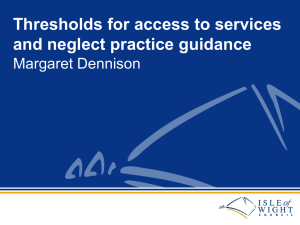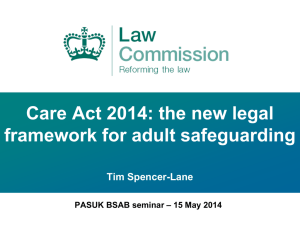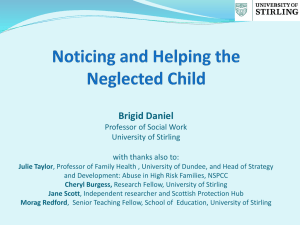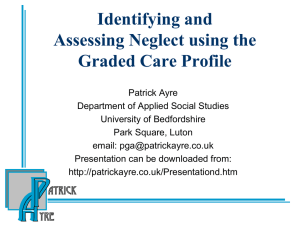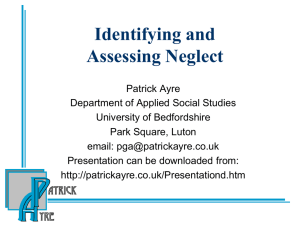- Bournemouth & Poole LSCB
advertisement
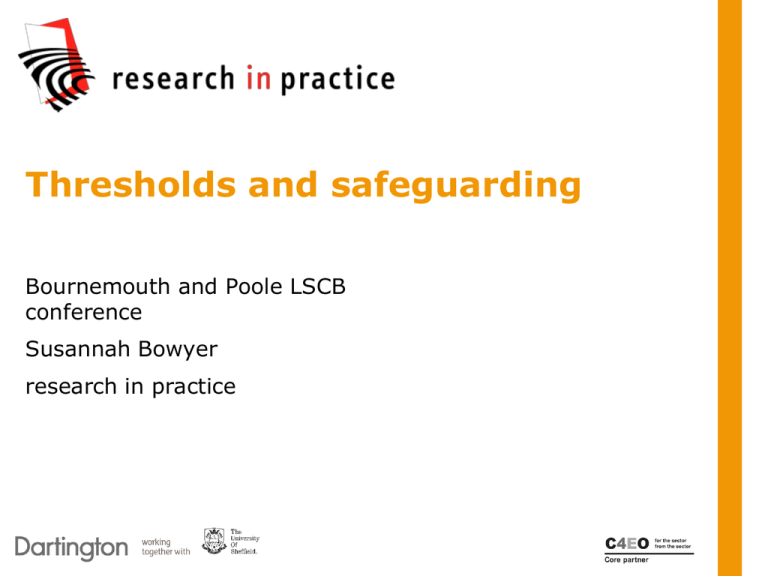
Thresholds and safeguarding Bournemouth and Poole LSCB conference Susannah Bowyer research in practice Prompt topic briefings 2010 Prompt 7 Thresholds for Children's Social Care 2009 Prompt 6 Parent and baby assessment placements 2009: Prompt 5 The Path to Independence: supporting young people move towards emotional, financial and practical independence 2008: Prompt 4 Effective targeting 2008: Prompt 3 Multi-professional working: distinct professional identities in multi-professional teams 2007: Prompt 2 Children on the edge of care: Intensive Family Preservation Services and Family Intervention Projects 2007: Prompt 1 Improving educational outcomes for looked after children Safeguarding –’everyone’s business’ ‘sustained tug of war between child protection and child welfare’ (Tunstill 1996: 152) Particular tensions between: Top end of tier 2 and the bottom end of tier 3, with operational definitions for S17 higher than the top end of CAF’s definition of vulnerability’ Cases coming down from statutory involvement Child protection ‘rarely comes labelled as such’ The preoccupation with Thresholds (Brandon et al 2008) Other selected findings from biennial analysis: 47% of the SCRs concerned children less than one year old ‘The theme of older adolescents who were very difficult to help emerged powerfully’ from the findings’ Long term neglect cases rarely met the threshold for formal child protection services The ‘start again syndrome’ is a common feature in long term neglect cases There was a lack of parental cooperation in more than two thirds of the 47 intensive sample cases The challenge of neglect Although 68% of children in cases subject to a CPP are registered under the category of neglect, many more cases do not meet the threshold criteria for CP work This situation is exacerbated by the ‘incident focus’ of child protection decision making The direction of travel of the last few years is supported by research evidence as the right one. Inevitably, more effective identification of need and safeguarding concerns leads to increased demand on services Maltreated children in the looked after system (Wade et al 2010) Comparison study of those who went home and those remaining lac Outcomes for those remaining lac were better in terms of stability and well-being Especially marked for neglected and emotionally abused children Decisions to reunify should be based on (Wade et al 2010): Careful assessment including clear evidence of sustained change in parenting capacity Provision of support services often at quite high intensities, will be needed to support successful reunions Where reunification failed, there were often early signs. Speedy decision-making is needed where home placements are in difficulty to reduce likelihood of further harm Conclusions A preoccupation with thresholds is not conducive to joined-up working across a safeguarding continuum The grey area between a NFA decision by children’s social care and CAF working must be clarified to address the issue of families bouncing off the CSC threshold repeatedly until they break through it New and upcoming resources: elearning on neglect (Spring 2011) Partnership conference: Serious Case Reviews. 30th November London Domestic Abuse: the impact on children and young people. 15th March Manchester Research messages workshop: Neglect: Recognition and response. 4th November London Safeguarding in the 21st Century (Barlow and Scott 2010) DfE neglect resources (Spring 2010) contact details: Bournemouth Link Officer Lin McCormack lin.mccormack@bournemouth.gov.uk susannah@rip.org.uk www.rip.org.uk


